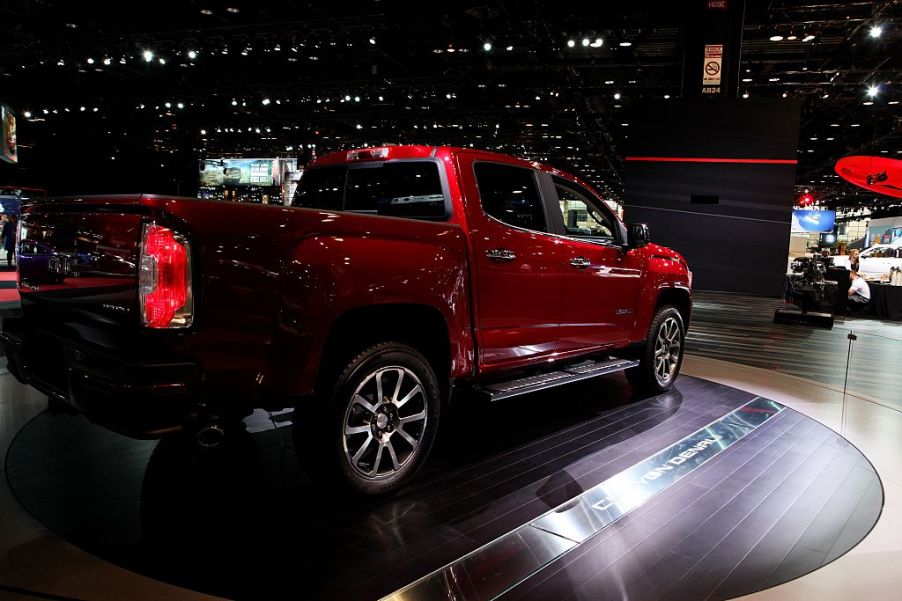
What’s Wrong With GMC Canyon Sales?
Times are hard for the auto world, and GMC is feeling the pain. Even though the truck division is currently red-hot, GMC’s smallest pickup truck, the Canyon, isn’t bringing in much money. It may be easy to assume that no one wants it, but the real answer is more complicated than that.
The Canyon is actually a great truck that has many features consumers like, but there are several factors that contributed to its poor performance in the fourth quarter of 2019. Here’s what GM Authority believes crippled the Canyon in 2019.
What were the GMC Canyon’s sales for 2019?
The GMC Canyon sold 32,825 trucks in 2019. This is a decrease from 2018 when GMC sold 33,492 Canyons. It was more than enough to land the Canyon in last place in the midsize pickup truck segment.
This had a lot to do with poor sales in the fourth quarter. Sales dropped an astonishing 21 percent, and as it was the final quarter of the year, the Canyon didn’t have a chance to recover. GMC sold only 6,525 Canyons in 2019. In 2018, the Canyon sold 8,219 in the fourth quarter. So what went wrong for the Canyon?
The competition
Just a few short years ago, the truck segment was ignored due to factors like high gas prices, and consumers’ love for fast cars. That’s changed, and now this once-neglected segment is garnering a lot of attention from both automakers and consumers.
The Toyota Tacoma had the highest number of sales at 61,179. The Ford Ranger came in second, followed by the Chevy Colorado, the Jeep Gladiator, and the Nissan Frontier. To add insult to injury, the Tacoma had more sales than the Chevy Colorado and the Canyon combined.
This isn’t because the GMC Canyon is a bad truck. It isn’t. Yet, although the Canyon has better safety ratings than the Ford Ranger, it still came in dead last. There’s more to the story of why the Canyon got wiped out by the competition, and it has nothing to do with a lack of appeal.
UAW strike of 2019 halts Canyon production
On September 16, 2019, GMC workers who were a part of the UAW joined together to go on a strike that lasted 40 days. This was due to low wages and three American plants being shut down. It was a decision that drastically impacted sales for the Silverado, Canyon, and other GMC vehicles.
According to CNBC News, the UAW strike completely stopped production on many models. This meant that no trucks were being shipped to dealers. It’s not hard to figure out that this meant consumers who wanted a Canyon couldn’t buy one. GMC had expected to produce 300,000 units during this time period, and the loss of labor cost the American automaker dearly. In fact, GMC lost almost $4 billion.
This had widespread consequences. GMC had to close several plants in Canada and Mexico because they couldn’t produce the parts needed to build the vehicles. It also had a negative impact on Michigan’s economy. Suppliers who make parts for GMC had to lay off workers temporarily and felt GMC’s pain in the form of financial loss.
On October 25, 2019, GMC finally agreed to the UAW’s terms, and the strike ended. The NY Times reports that workers were given a salary increase and an $11,000 bonus per worker. GMC also promised to invest more in American factories.
The workers weren’t given everything they wanted, however. The three plants that were shut down are going to remain closed. Still, the workers earned most of the things that led them to organize a strike.
What’s in store for the GMC Canyon in 2020?
Whether the GMC Canyon is able to recover in 2020 is still unclear. The coronavirus pandemic has shut down GMC’s production lines once again. If they open soon, the Canyon may be able to recover and take back lost ground. If not, the Canyon may be in for another bad year.


